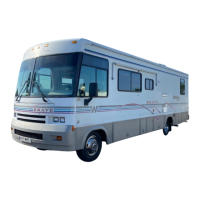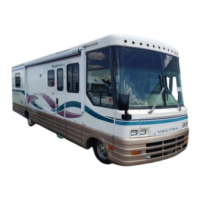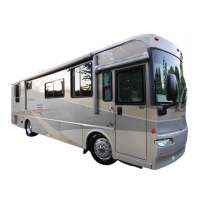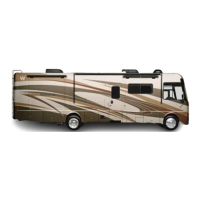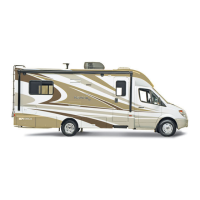
Do you have a question about the Winnebago Navion iQ and is the answer not in the manual?
| Manufacturer | Winnebago |
|---|---|
| Model | Navion iQ |
| Category | Motorhomes |
| Gross Vehicle Weight Rating (GVWR) | 11, 030 lbs |
| Fuel Capacity | 24.5 gallons |
| Chassis | Mercedes-Benz Sprinter |
| Engine | 3.0L V6 Turbo Diesel |
| Horsepower | 188 hp |
| Torque | 325 lb-ft |
Manual prepared to aid in proper care and operation of vehicle and equipment.
Terms (Danger, Warning, Caution, Notice) alert to precautions for safety.
Dealer responsible for pre-delivery inspection of chassis and motorhome components.
Recommendation to check and adjust front suspension and steering alignment after loading.
Dealer provides information, answers questions, and offers maintenance and assistance.
Inform NHTSA and Winnebago Industries of defects causing crash, injury, or death.
Label showing occupant/cargo capacity, seat belt positions, and weight counts.
Label with VIN, vehicle identification, and important reference information.
Key physical and fluid capacity data for different models.
Fields to record owner and vehicle details for reference.
General safety guidelines for occupants and vehicle operation.
Essential pre-operation checks for safe vehicle driving.
Safety precautions for handling and using fuel and propane systems.
Procedures to follow if propane gas is detected in the vehicle.
Details on the coach's carbon monoxide detection alarm.
Information about the coach's smoke detection alarm.
Location and maintenance recommendations for the fire extinguisher.
Critical safety precautions when working with electrical systems.
Guidelines for securing loose items and distributing weight properly.
General maintenance advice for the vehicle.
Information on how to use escape windows and exit procedures.
Safety warnings and procedures for operating slideout rooms.
Information on formaldehyde emissions and health effects in the vehicle.
Advice on preventing mold growth and managing moisture.
Procedures for handling a roadside emergency, including flat tires.
Information on standard steel wheel lug nuts and their installation.
Instructions for jump-starting the engine using the battery boost switch.
Procedures for handling an engine overheating condition.
Information on adjusting driver and co-pilot seats.
Proper use, adjustment, fastening, and release of seat belts.
Guidelines for properly installing and using child restraint systems.
Operation of the remote keyless entry system for doors.
Purpose and operation of hazard warning flashers.
Features and operation of the audio system and rearview monitor.
Features of the all-in-one infotainment, GPS, and audio system.
Using the switch to draw power from house batteries for starting.
Precautions and checks for the engine cooling system.
Accessing wheel valve stems for tire pressure checks.
Factory alignment and periodic inspection for tire wear.
Operation of the refrigerator on different energy sources and leveling.
Operation of the propane gas range top and avoiding asphyxiation.
Information on operating the microwave oven.
Central panel for checking utility systems, generator, and water pump.
Operation of the dual-power water heater.
Steps for starting up and shutting down the propane gas furnace.
Operation of the heat pump for heating and cooling.
Control of the air conditioner via the furnace thermostat.
Overview of the propane gas system and its fuel sources.
Process for refilling the permanently mounted propane tank.
Precautions for safe operation and maintenance of the propane system.
Warnings and precautions for traveling with propane and handling leaks.
Protection and installation of the propane pressure regulator.
Critical safety precautions when working with electrical systems.
How the 120-volt AC system operates from shore power or generator.
Function and use of the 12V to 120V AC inverter.
The converter panel with circuit breakers and fuses.
Safety precautions for operating the generator.
Overview of the 12-volt DC system components.
Using the switch to disconnect house batteries during storage.
Proper care and maintenance for lead-acid batteries.
Protection of 12-volt circuits by fuses and breakers.
Overview of the fresh water system and its supply sources.
Operation of the demand water pump for supplying water.
Methods for winterizing the water and plumbing system.
Procedure to winterize by blowing out waterlines with compressed air.
Procedure to winterize by filling lines with RV antifreeze.
Chart detailing locations of various water system drain valves.
Operation of the 12V LED TV.
Basic operation of the audio-video system.
Features and operation of the DVD player.
Operation of the digital TV antenna for reception.
Function and control of the TV signal amplifier.
Safety warning regarding use of sleeping facilities while vehicle is in motion.
Converting the sofa sleeper to a bed and adjusting firmness.
Setting up the dinette table.
Converting the sectional dinette to a bed.
Converting the Flex Bed system between twin and queen sizes.
Information on wood types, finishes, and care for cabinetry.
Operating electric slideout rooms and safety precautions.
Troubleshooting slideout room issues related to voltage or circuit breakers.
Procedure for manually overriding slideout room operation.
Steps for manually pushing in a slideout room.
Routine care and maintenance for slideout room seals and mechanisms.
Importance of inspecting and maintaining sealants to prevent water entry.
Precautions for maintaining the vehicle's paint finish.
Proper methods for washing the RV to avoid scratches.
Cleaning wooden cabinets and furniture.
Care and maintenance for stainless steel appliances.
Care and maintenance of vinyl flooring.
Steps for preparing the vehicle for storage.
Recommended maintenance schedule for various coach systems.
Guidelines for loading the vehicle, distributing weight, and understanding ratings.
Hitch capacity, tongue weight, and towing recommendations.
Operation of the electric entry step and safety warnings.
Operation of the power awning and its ignition lockout system.
Dealing with condensation and humidity during extended occupancy.
